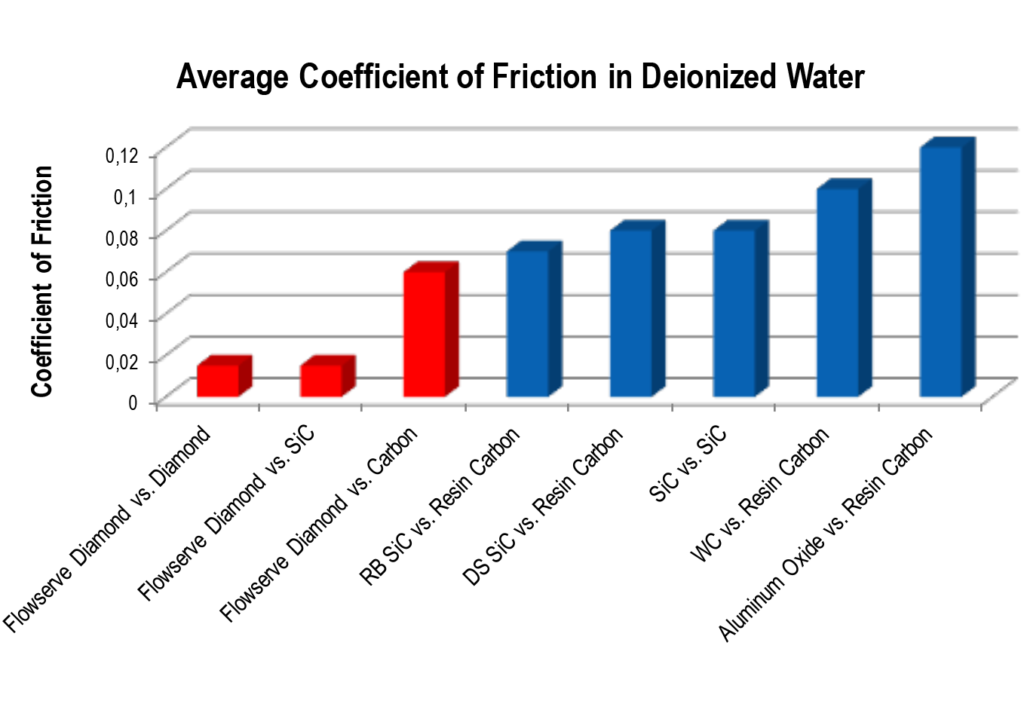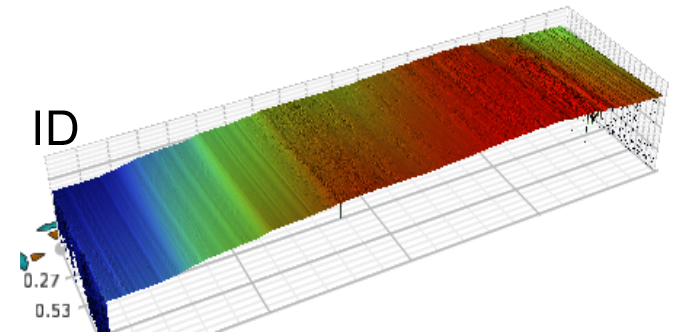Diamond Seal Face Technology
Seal face materials have always been challenged to provide reliable operation in low lubricity fluids. In the past, this challenge was addressed by lubricating seal faces with a cool, clean external fluid. Although effective, this solution adds operating cost throughout the life of the seal. Alternatively, dual seals operating on clean barrier fluid offer longevity with lower operating cost, but higher initial cost for the required support system. The ideal answer for seal users is mechanical seals lubricated directly by the process fluid. UNCD coated silicon carbide as a seal face material enables Flowserve to offer improved reliability in poor lubricating fluids without additional environmental controls.


Features and Benefits
- The lowest friction of any seal face material provides cool running seal faces in poor lubricity fluids such as hot water
- Bonding the hardest known material to the seal face running surface gives maximum resistance to abrasive particle damage
- The highest chemical resistance of all seal face materials enables its use in aggressive acids, alkalines, and caustics
- High wear resistance brings forgiveness for off-design operation such as intermittent dry running
- Fine grain nanocrystalline diamond allows operation against all common mating face materials including carbon, silicon carbide, tungsten carbide, and itself.
- Certification of biocompatibility per USP Class VI is available.
Why use Diamond Coatings?
Diamond’s material properties provide advantages for seal faces
Diamond is the hardest known natural material
- Wear resistant
- Abrasion resistant
Low friction characteristic based on grain structure
- Dry run tolerance
- Low breack-out torque (dry)
High thermal conductivity
- Transfer seal face generated heat
Chemically resistant in acids, alkalines, and solvents
- More resistant thank any typical seal ring material
How Diamond Coatings are Applied
Coating type varies by manufacturing process. Process control is significant
Flowserve uses HF-CVD (hot filament chemical Vapor Deposition)
- 2000-2100°C (3600-3800°F) hot filaments positioned over substrate parts at 600-800°C (1100-1500°F) in a carbon-rich gas chamber grow diamond grains on the substrate
- Diamond is grown from the seal face; chemistry bonds the diamond to the substrate

General Application Range
Operating Parameters
Pressure: 0 to 140 BarG (0 to 2000 PSI)
Temperature: -40 to 204 C (0 to 400 F)
Speed: up to 46 m/s (150 fps)
Viscosity: 0.2 to 5,000 cP
Specific Gravity: 0.4 to 2.0
Sizes: 25.4 to 280 mm (1.000 to 11.000 inches)
These are not firm limits, the range of diamond coating experience continues to increase.
TEST RESULTS:
How Diamond Coatings Compare
Diamond coatings offer exceptional hardness

Hardness is an indicator for resistance to three-body abrasion

Hardness is an important property in applications containing abrasive solids

How Diamond Coatings Compare
Diamond coatings offer extremely low friction
- Lower friction can equal lower wear
- Diamond exhibits low frictions when operating on either liquids or gases

How Diamond Coatings Compare
Diamond coatings offer extremely high thermal conductivity
- High thermal conductivity translates into consistent temperatures across the seal faces
- Seal face temperatures are closer to the bulk fluid temperature

Wet-Dry-Wet Running Performance
UNCD coatings show significant increase in dry running life compared with SiC vs. SiC faces
- UNCD vs. uncoated SiC provides short term dry running performance similar to uncoated SiC vs. Carbon


Test result – Dry Running UNCD vs SiC
ISC2 1.875 dry run testing
- SiC vs SiC (YO) 50 seconds to reach 260°C (500°F) – Extrapolated
- UNCD (K30) vs SiC 7 minutes to reach 260°C (500°F)
8 times longer
Test Result – Dry Running UNCD vs UNCD
SLC Group 1 dry run testing @ 1450rpm
- SiC vs SiC (YO) 53 seconds to reach 220°C (428°F)
- UNCD vs UNCD (K30) 12 minutes 10 seconds to reach 220°C (428°F)
–13 times longer

Test Result – Partial Dry Running with Water
ISC@ 1.875 dry run testing @ 4,800 rpm
- Enlarged bore seal chamber with residual water
- Maximum temperature reached after 90 minutes was just 85°C (185°F)
108 times longer than SiC vs SiC under the same conditions @ 3,600 rpm

Comparison of Wear Post Test

Tungsten Carbide

UNCD Coated SiC

Uncoated SiC

Uncoated SiC
Test Results – Warm Water
This SiC face was run
opposite another SiC face in
68°C (155°F) water for
200 hours
This K30 diamond coated
face ran in the same service
for 4,000 hours with barely a
witness mark

TARGET APPLILCATIONS:
Providing solutions for challenging applocations
Low wear
- Intermittent dry running
- Loading and unloading applications
High hardness
- Three- body abrasion on seal face running surface
- Slurries
- Silicon carbide scoring and binder pullout can be eliminated
Reduced friction
- Hot water
- Multiphase fluids
- Gas entrainment
USP Class VI tested and approved
- Food and pharmaceutical applications

Target Applications
Upstream oil & Gas
- Produced water
- Crude oil pipeline
- Multiphase pumps
Power
- FGD slurries
- Boiler feed water
- River water (dirty water)
Refineries
- Dirty hydrocarbons
- Light hydrocarbons
Mining / General Slurries
- Fibrous slurries
- Abrasive slurries
- Batch processes
Chemical
- Loading / unloading pumps
- Fluids with entrained gases
- Solutions with abrasives
- Caustics
- Strong acids
- Solvents
- Warm water




